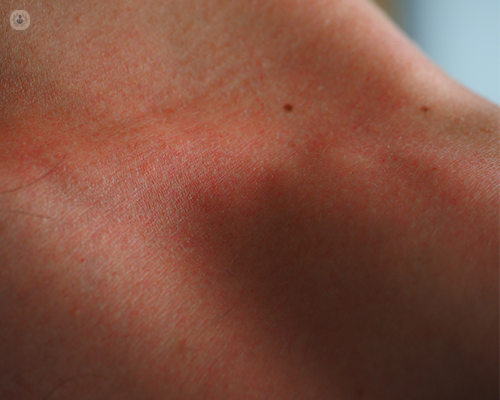Your brief guide to skin allergies: immediate and delayed reactions
Written by:Allergic reactions on the skin usually produce itchy rashes. There are two main ways that the skin can develop allergic reactions and depending on which reaction, the skin reacts very differently.
Professor Andrew Wright, a leading consultant dermatologist, provides you with a brief but thorough guide on immediate and delayed rashes along with the testing involved.

What are immediate allergic reactions?
Some reactions are immediate and happen within seconds or minutes of being exposed to a material. The way this reaction occurs is similar to the reaction that people get when they suffer from hay fever or allergic asthma. These reactions are commonly due to things such as house dust mite, animal fur, feathers and pollen.
These reactions typically produce a blotchy, red, itchy rash, usually in the form of a rash called urticaria, which is sometimes referred to as hives. Individual patches of rashes last from a few minutes to several hours and then fade, usually without leaving a mark.
Many foods can cause immediate reactions like this with some examples being:
- strawberries;
- shellfish;
- eggs;
- nuts;
- wheat, and;
- a variety of other foods.
People who have eczema, asthma and hay fever are more likely to get these sorts of allergies. A food allergy of this form is very likely to set off their eczema and may occasionally make asthma worse.
The previously mentioned allergies are investigated by prick testing. In this test, a small diluted quantity of the suspected allergic material to be tested is pricked into the skin and the reaction is measured. These tests are usually performed in a hospital setting. Additionally, sometimes blood testing can also be used to investigate these allergies.
What are delayed allergic reactions?
The second type of allergy is a more delayed reaction. This usually occurs due to contact with materials and appears 12 to 72 hours after the contact, usually at the direct site of contact with skin. This produces an itchy rash very similar to forms of eczema.
This type of allergy can develop in almost anybody. Furthermore, it can be caused by commonly used household and work-related products. Examples are:
- chemicals used in the manufacture of rubber gloves
- metals such as nickel and cobalt, which are commonly present in jewellery
- paraphenylene diamine, which is used in hair dyes
- fragrances and preservatives which are used particularly in cosmetics
The pattern of such a rash sometimes provides clues. For example, rashes on the hands with a cut-off point at the wrist may well be related to gloves. Rashes and irritation on the ear lobes could be related to nickel in earrings. Sometimes, such clues are not obvious and investigations are necessary.
This type of allergy is investigated using patch testing. This involves applying the suspect material in a diluted form on to the back or another similar body site. Materials are then left on for 48 hours and followed by a reading to see if there has been a reaction. Patients are usually then seen again a further 48 hours later. These types of tests are usually done by hospital-based specialists. The tests and results can sometimes require significant interpretation and investigation into their relevance but can often be extremely helpful in helping to sort out complex and difficult rashes.
Professor Andrew Wright is a leading expert in the diagnosis and management of numerous skin conditions. Visit his Top Doctors profile to learn how he can assist you in looking after your skin and health.



